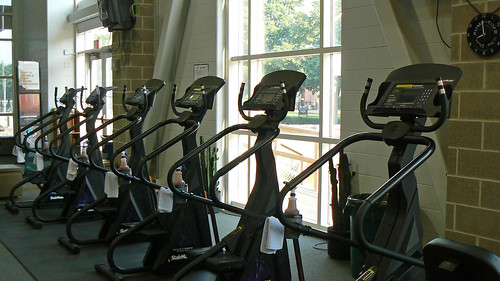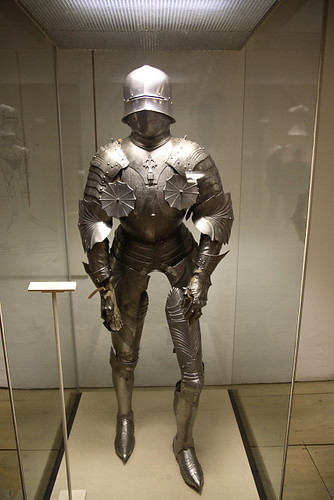Saturday night, I went to the wedding of a friend from my childhood. It was the first time that both my husband and I had been out, together, child-free, and with a safe ride home in over a year. We drank, danced, laughed, and had an amazing time.
Then I got up Sunday morning and ran three miles.
Should you praise me? Do I deserve a gold star?
Sure, after a night of partying, it would have been a little easier to just tuck myself back into bed. So it took an element of discipline and willpower to get going. And yes, I think discipline and willpower are positive qualities, but I don't run to punish myself or beat my body into some sort of submissive rhythm. I run because I like it.
And I don't think that I deserve praise for it any more than I deserve praise for, say, getting really good at chess, learning to play an instrument, knitting an awesome scarf, or parachuting out of an airplane.
I was thinking about this today because I read
an interesting article that examines whether the Health at Every Size approach has a healthism problem. It explains healthism as a concept:
Healthism was originally defined by Robert Crawford as a “preoccupation with personal health as a primary – often the primary – focus for the definition and achievement of well-being.” It has evolved into the often unspoken idea that there is a moral value to health; it emerges as the assumption that people should pursue health.
Healthism as it manifests itself in our cultural norms is a deeply privileged position:
It seems to me that healthism is reflective of deep privilege; it is (in my opinion) a classic “first-world” problem. Healthism can only thrive in a culture where the dominant groups do not have to worry about such things as famine, infectious disease, war, poverty, and hatred as factors that affect their health. It’s privilege that allows us to make health a “project” that we can judge others for not taking up.
And at the end of the article (which you should really go read in its entirety, as I'm not even touching on some of its more interesting points), we're asked this question:
Do we need an asterisk on every health recommendation – an implied “but only if you want to”?
The Moral Imperative To Health
If you spend much time at all reading about fat activism or Health at Every Size approaches, you'll see people arguing that health is a moral imperative because of the collective costs to society that the unhealthy bring with them. They'll talk about shared healthcare expenses and the Puritanical notions of moderation and personal responsibility in the maintenance of a particular level of fitness.
It is your responsibility to your self and to your community to be as healthy as you can be, the logic goes.
 |
| It's right up there with jury duty. Slog through it for the good of the whole! |
I don't buy it.
I don't buy it for a couple of different reasons. First of all, if we culturally valued health as a moral betterment for the society at large, then Lululemon wouldn't be saying that their pants aren't designed for large bodies or that they can't be made beyond a size 12. When Professor Rebecca Hains
explained her petition against the company, several of the commenters demonstrated a cultural norm that has nothing to do with health and everything to do with appearance:
Nobody....and I mean nobody, wants to see a size twelve woman wearing yoga pants! It would be the equivalent of two St.Bernard dogs stuffed into a black bag having a fight as she walked down the street! And enough with the stupid mantra that everybody gets a cupcake for just for being there! The company that produces this line of clothing are designed for people who actually care about being fit and looking good not a bunch bob bon eating slobs who are too fat to put on a pair jeans! -ziggy24
It is a crime against humanity when a plus-size woman wears stretch pants. Sickening. If that makes me a sexist so be it. This professor is an idiot. -EddieD_0206
I wear a size 12. Apparently, I am committing a "crime against humanity" every time I put on some athletic wear and go for a run. At the same time, I am failing to do my cultural duty of ensuring I am healthy enough not to be a burden on society if I
don't put on those pants and go for a run. Fat people--we just destroy society no matter what we do.
If the mantra for health in American culture truly were about the personal responsibility of individuals to be as healthy as they can, then people would be praising fat people for working out and demanding that our high-end athletic companies make clothes that allow them to do that. We would also pay attention to the research that suggests thin and healthy aren't all that correlated anyway.
But we're not (at least most of us aren't), and it's because we really don't care about collective health at all. We care about reinforcing narrow beauty ideals, and if someone eats nutritiously void food and never works out but is a size 2, we don't bat an eye. I haven't heard people lining up to call that a "crime against humanity."
But the second reason I don't buy the health as collective moral imperative argument is because there are
plenty of things that are good for us that we aren't required to do to be considered an acceptable member of society.
Take one of the examples I used above. Playing chess has
scientifically-supported health benefits. It grows dendrites in the brain, reduces the risk of Alzheimer's, and improves problem-solving skills. If you can argue that you have to work out in order to reduce the social cost of supporting your healthcare, couldn't you also argue that you have to play chess to reduce the social cost of your poor problem-solving? After all, our social safety nets have to catch you when you can't solve your problems yourself.
But why stop there?
Playing a musical instrument has been
linked to a reduction in biological stress responses linked to heart disease and cancer.
Learning a second language
protects against dementia.
I'm sure that scrapbooking increases spatial reasoning skills, singing increases lung capacity, and basket weaving improves dexterity.
And if we're truly concerned with ensuring that every person reduces their potential negative impact on the collective health costs, then we should also penalize athletes who get injured or put themselves in dangerous situations like running on roads or climbing trails where they might fall.
The health-as-collective-responsibility argument just doesn't hold up with the demands we actually make on people.
So, Can I Have My Gold Star Now?
Since everyone in the whole world has written about it, I'm sure you've seen this picture:
Plenty of
people have
taken this photo to task. While it purports to promote health, it really only promotes a particular definition of beauty. The implication is that other mothers are using their children as an "excuse" to keep them from their moral obligation (to themselves and society) of fitness.
I can't imagine a picture of a chess player posed sexily with her pawn in hand while her children play at her feet. "What's your excuse?" Imagine a violinist making bedroom eyes over his instrument while his kids run in the background: "What's your excuse?"
Fitness (especially the type of fitness activities Maria Kang promotes) is a choice that requires a commitment of time and energy. It's a choice just like any other hobby or activity that we choose to do. We all have the same 24 hours in the day. Some of us have more of it taken up by specific obligations on our time than others (someone who works two jobs to pay the bills or has to spend three hours on a bus each day to get to and from school (as many of my students do), for instance, doesn't have quite as much hobby time to play with).
Still, on average, we all have some flexibility on how we spend our spare time. This video does an amazing job of summing that up (watch it. Really.):
At the end, it asks how you will spend your time. You have lots of ways you can answer. You can spend it running miles of pavement while listening to Fannie Flagg's new book on Audible (that's what I did this week). You can spend it learning to play the violin. You can spend it reading War and Peace. You can spend it playing chess. You can spend it painting portraits, cooking fresh bread, creating scrapbooks to keep your memories fresh, decorating your home, shopping for new clothes, playing with your pets, making crafts with your children, doing crunches, restoring old furniture, writing blog posts, riding roller coasters, traveling the world, gardening, canning peaches, sculpting, learning French, watching bad horror movies. . .
For most of us, we use that time in a combination of activities. Some make us happy and fulfilled. Some we do out of obligation or to help make someone else happy and fulfilled. Some we do for our health. Some we do for fun.
Every once in a while, we hit upon an activity that combines all of those things into one. Do those things. They're rare.
And when you find things you like, find people who like them, too. Get a community of people who can encourage you to finish knitting that big project, paint that wall in the complicated pattern, master that hard song on the guitar, run that marathon.
And when you see someone sharing an accomplishment, encourage them. They don't need gold stars, but they might need your support.
Life is short. Use it well.














